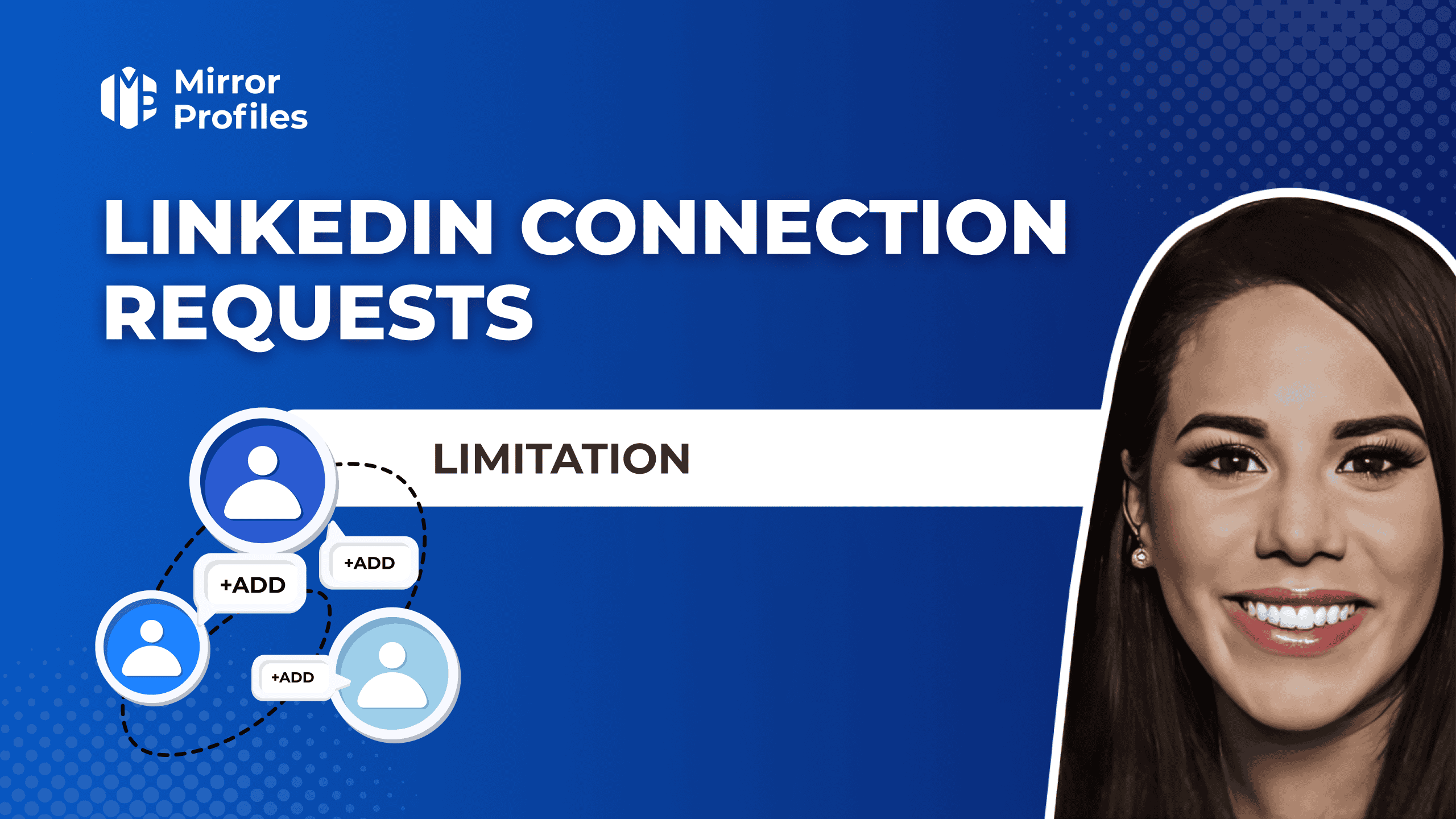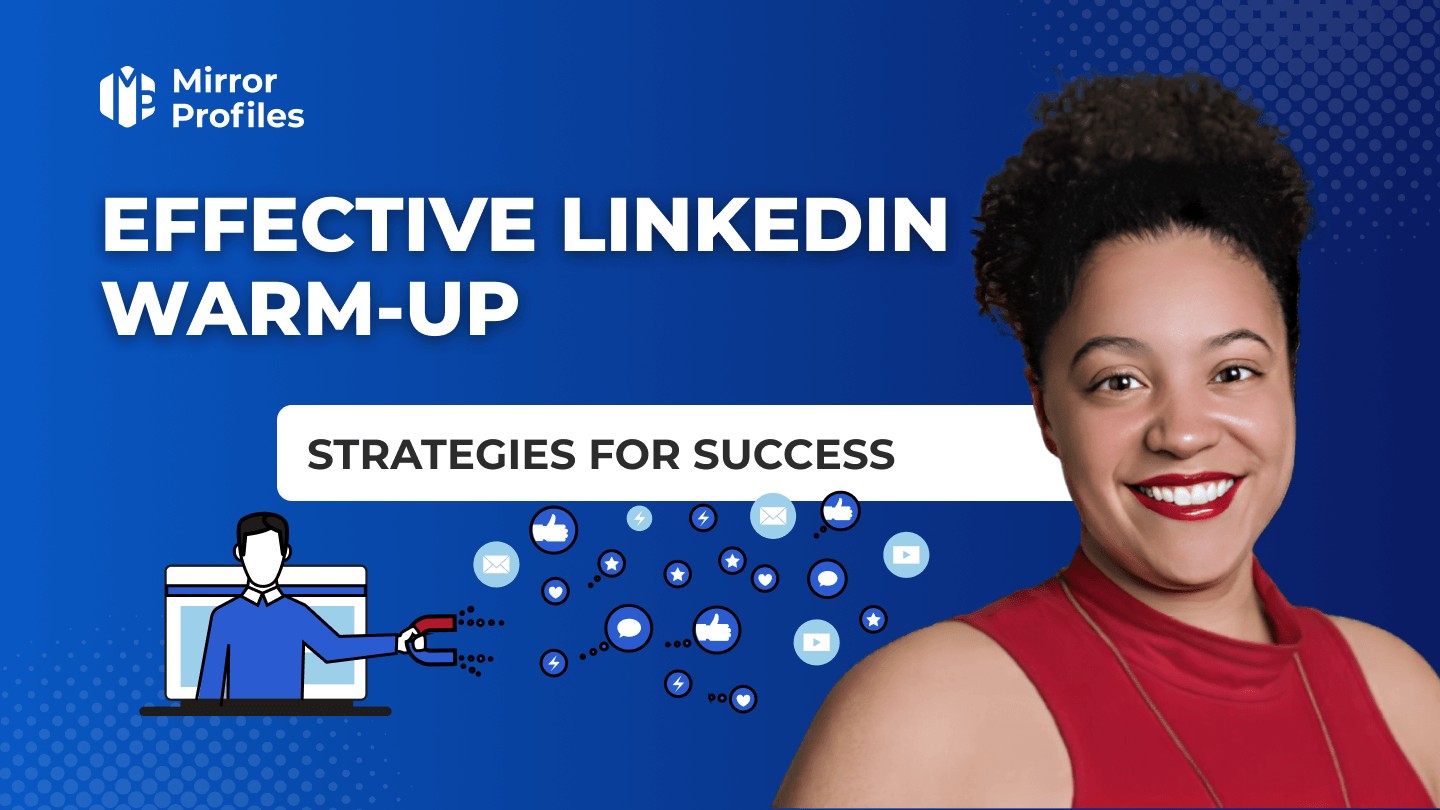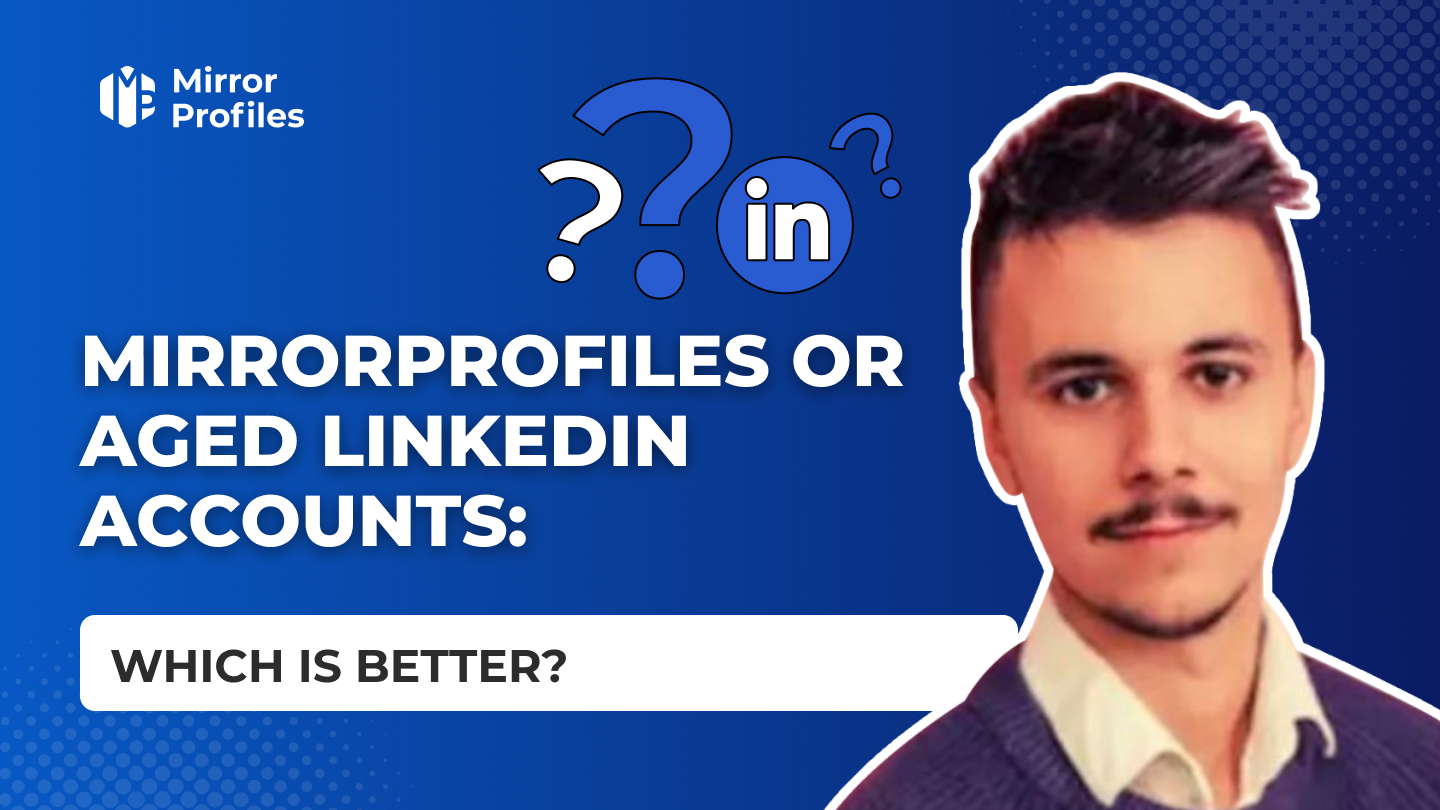Sales prospecting is crucial for companies wishing to increase their sales, generate new leads, and ensure their business growth. This time-consuming, complex, and often frustrating task requires a wide range of skills and a dedicated team. However, by using data-driven tools and AI, businesses can make this process more efficient and effective, saving valuable time. So pairing MirrorProfiles for quantity and AI for quality, you’ve got the winning combination for effective LinkedIn outreach and lead generation.
In this article, you’ll learn how AI can transform your LinkedIn prospecting—the professional social network par excellence, now surpassing one billion users. Discover how AI helps you effectively target your audience, build personalized prospecting campaigns, automate your contact and email follow-up, evaluate campaign performance using data insights, and finally, optimize your outreach for better engagement and higher conversion rates. We’ll also share case studies and examples illustrating the successful use of AI tools in LinkedIn prospecting, while addressing the limits to be considered and the ethical issues at stake.
Are you ready to boost your sales prospecting with the help of AI? Follow our guide to enhance your team’s efficiency and generate high-quality leads!
Foreword: Why choose Linkedin for AI-powered prospecting?
The platform offers fertile ground for commercial prospecting. It gives you a unique opportunity to identify qualified prospects, decision-makers, influencers, and potential partners from a wide range of industries, enhancing your company’s outreach efforts.
What’s more, the network allows you to establish yourself as an expert in your field, build trusted relationships with your audience, and drive significant traffic to your website or blog. But what’s the key to maximizing your business prospects on LinkedIn? The answer lies in leveraging data and AI-driven strategies.
The answer lies in the intelligent use of artificial intelligence (AI) tools, which can streamline your prospecting process and enhance your team’s productivity.
Artificial intelligence, with its advanced technologies, enables machines to simulate human abilities such as reasoning, learning, perception, and communication. It proves to be an invaluable asset in improving your efficiency on this social medium, saving you time and boosting your sales performance.
How can AI help you? It makes it easy to identify your target audience, create personalized exchanges, automate contact and follow-up tasks, check performance metrics, and fine-tune your campaigns for better results.
In the rest of this article, we’ll guide you through the ways you can leverage AI to enrich your prospecting approach, highlighting the most effective tools and the best strategies to adopt for superior lead generation.
Far from being a threat, AI is proving to be a real opportunity to amplify your sales prospecting. But rest assured, AI will never be able to close a deal as well as your sales agents! It’s a tool, an aid, and in no way a substitute for your dedicated team.
Identifying your target audience with AI
To turn your LinkedIn prospecting efforts into a success, an acute understanding of your target audience is crucial. Rather than approaching people randomly, it’s essential to focus your efforts on the profiles most in tune with what you have to offer, ensuring higher quality leads.
How do we get there? Artificial intelligence (AI) is the key. It allows you to pinpoint the profiles most relevant to your prospecting approach by analyzing data and using advanced algorithms, thereby enhancing your lead generation process.
Find the right profiles
With AI, filtering LinkedIn profiles becomes child’s play. You can refine your search using a variety of data: industry sector, company size, position held, location, experience, skills, and interests, to name a few. AI tools such as Apollo and Dripify prove invaluable. They integrate with LinkedIn Sales Navigator, making it easy to create lists of qualified prospects and export these contacts to your CRM or other engagement platforms.
Snov.io or Aeroleads, which scan LinkedIn data, can also automatically suggest profiles matching your criteria while providing verified contact details, streamlining your outreach process.
For our part, we like to create our own databases. Here’s how I do it:
I enrich my entire CRM with prospect URLs and LinkedIn Company URLs.
Then, using MirrorAPI, I visit all the LinkedIn URLs to obtain all the data on both the person and the company, ensuring comprehensive input for better lead generation.
I merge the two databases and create one database with over 50 columns. Manually finding recurrences would be complicated, but AI simplifies this research task.
I upload the CSV into ChatGPT, simply asking it to find me the recurrences and explaining that this represents my customer portfolio.
By testing several prompts, you’ll get extremely precise targeting that you can easily duplicate in LinkedIn Sales Navigator, enhancing your outreach efficiency.
Then I keep the ChatGPT conversation and each time I scrap, I ask it to clean up the CSV by removing all the profiles that don’t match my personas, ensuring high-quality leads.
That’s how you can use AI to obtain highly accurate prospecting files with up-to-date data, adding significant value to your sales process.
Data analysis for a tailored content strategy
AI doesn’t just filter profiles; it also enables in-depth analysis of the data collected. This helps you fine-tune your content strategy so that it truly resonates with the needs, expectations, and motivations of your target prospects. With personalized communications, your chances of generating interest and receiving a response are greatly increased. Tools like SignalHire or Skrapp are useful for collecting detailed information on the activity of targeted LinkedIn profiles, including publications, comments, and recommendations.
For high-impact writing, solutions such as Crystal or Phrasee are invaluable. Relying on natural language processing (NLP), they analyze the psychological profiles of your prospects to adjust the tone, style, and composition of your emails, making them resolutely effective. Some of our customers use this with our MirrorChat tool, enabling them to optimize their responses to maximize their response rate and overall engagement.
Creating personalized prospecting messages with AI
Once you’ve targeted your audience, the next step is to arouse your prospects’ interest and curiosity about your offer. You may be wondering how to write personalized prospecting sequences that stand out from the hundreds of others your prospects receive every day. The use of artificial intelligence (AI) allows you to design powerful copy, adjusting content, tone, and style for each prospect. But first, don’t forget to tell them about the best LinkedIn copywriting practices 😉
Using AI tools for copywriting
AI enables you to create texts that are perfectly aligned with your prospects’ specific needs, expectations, and motivations. In this way, you can develop unique exchanges that capture their attention and encourage them to interact with you. Tools like Crystal or Phrasee, which use natural language processing (NLP) to examine the psychological profile of your prospects, make it easy to personalize the tone and style of your communications.
Platforms like Copy.ai or Writesonic, which use deep learning, help you generate original, creative, and captivating copy. The big advantage is when you have a lot of information to provide so that the AI can learn. For example, our MirrorProfiles blog has over 100 articles, each offering different tips and tricks for better prospecting on LinkedIn. Thanks to this rich resource base, AI tools are able to create communications that are equivalent or even better than what we are capable of writing.
Automated A/B testing to optimize approaches
AI also plays a crucial role in testing and optimizing your prospecting with automated LinkedIn A/B tests. This technique enables you to compare the effectiveness of different pieces of copy based on indicators such as open rates, response rates, and conversion rates.
This process helps identify the best-performing copy, which can be reused in future campaigns. Tools like Persado or Phrasee, specialists in automated A/B testing, use data analysis to refine your copywriting according to the preferences of your target audience, ensuring higher engagement rates.
Automated contact and follow-up
Personalized messages are a crucial first step. However, sending them to your prospects on LinkedIn and following up regularly to maintain their interest are just as important in moving them along the sales funnel. You’re probably wondering how to manage these stages efficiently, without spending hours on them or losing the thread of your exchanges?
Artificial intelligence (AI) provides a solution by enabling automated contact and follow-up. AI-based tools can significantly save you time while improving your productivity and performance, allowing your team to focus on high-value tasks.
AI to automate invitations and follow-ups
AI makes it easy to send invitations and prospecting messages to your prospects on LinkedIn. It does this by relying on predefined, customizable scenarios, enabling you to schedule your outreach at the most relevant times, taking into account the behavior and responsiveness of your prospects. It also offers the possibility of automatic follow-up by sending appropriate reminders, until a reaction is obtained, whether positive or negative.
Tools like Skylead, Dripify, and Hey Reach integrate perfectly with LinkedIn, enabling you to set up automated, customized prospecting campaigns that streamline your outreach process and enhance lead engagement.
Response management and interaction thanks to AI
AI can also take care of managing your prospects’ responses on LinkedIn, enabling you to interact with them in a fluid, natural way. This is a feature we’re going to integrate into MirrorChat. It gives you the opportunity to respond appropriately to your prospects’ questions, objections, or specific requests, using either pre-set answers or those generated by AI, and soon they may even be automatic.
What’s more, AI can be used to qualify your prospects by asking them the right questions and directing them to the next step in their buying journey, whether that’s for a demo, an appointment, or a quote, ensuring a more efficient sales process.
Performance analysis and campaign optimization
Once you’ve automated the contact and follow-up of your prospects on LinkedIn, it’s crucial to examine the performance of your prospecting campaigns. This step helps you to optimize your approach in relation to the results obtained. But how do you evaluate your initiatives and identify areas for improvement? Artificial intelligence (AI) provides a solution by enabling you to analyze and optimize your campaigns through software offering valuable insights to fine-tune your process. The key is to use a webhook via your automation tool or, better still, your MirrorChat to send the information to MirrorCRM, which is equipped with a Mini-extension that will perform the review work for you thanks to its ChatGPT AI.
AI is a valuable asset that helps you quantify the efficiency of your prospecting efforts on LinkedIn. It uses key performance indicators, such as the number of prospects engaged, open rates, response rates, conversion rates, cost per lead, and return on investment (ROI). These metrics not only allow you to evaluate the reach of your campaigns but also to compare them with each other, so you can identify which ones are working best.
They offer data visualization through dashboards or detailed reports, making it easy to review your actions and derive meaningful insights for future campaigns.
Strategic adjustments based on AI data
What’s more, AI makes it easier to optimize your LinkedIn prospecting campaigns by leveraging the data collected. It enables you to review and adapt the parameters of your actions, such as targeting, timing, and frequency of mailings, in relation to the insights revealed by AI.
This technology also gives you the opportunity to test new hypotheses and experiment with different approaches. Tools like Persado or Phrasee can advise you on best practices and opportunities for improving your prospecting operations, thanks to the intelligent use of data and insights.
Create a profitable Linkedin prospecting system by combining quantity and quality
As we have seen, AI will enable you to increase the quality of your automations. However, on LinkedIn, there are limits to the number of connection requests or messages for one account. But imagine owning 5, 10, or even 50 accounts? Coupled with AI and automation provided by tools like Hey Reach, you end up with a powerful outbound sales team!
MirrorProfiles makes this possible! We rent out LinkedIn profiles that are verified, secure, and ready for automation. You now have all the tools you need to develop a highly profitable LinkedIn prospecting system, enhancing your team’s efficiency and lead generation capabilities.
Case studies: AI success in Linkedin prospecting
Let’s explore the benefits of AI in LinkedIn prospecting through concrete case studies. These real-life examples show how different companies have amplified their sales prospecting on this professional social network thanks to AI, increasing their leads and conversion rates.
HubSpot is an integrated marketing and sales solution that helps organizations attract, convert, and retain new prospects. By leveraging AI tools such as Crystal or Phrasee to generate customized, high-performance communications, HubSpot has seen its response rate jump by 20% and its conversion rate rise by 10%.
Captain Prospect is an agency specialized in commercial prospecting, guiding companies in the development of their strategy. Using AI to evaluate performance and fine-tune campaigns on LinkedIn, with the help of tools such as Apollo or Persado to assess the relevance of prospecting copy and recommend the best strategies, Captain Prospect has enabled its customers to achieve an average response rate of 35% and an average conversion rate of 15%.
These examples perfectly illustrate that AI represents an important lever for prospecting on LinkedIn, offering time savings and improved results. Far from supplanting sales agents, AI is there to support them and optimize their prospecting approach, enhancing overall team performance.
Limits and ethical considerations in the use of AI in prospecting
When it comes to prospecting on LinkedIn, Artificial Intelligence (AI) offers undeniable advantages. However, it also involves significant ethical, legal, and human issues that cannot be ignored. Addressing these challenges with responsibility and caution is imperative for the ethical use of AI in business.
AI and discrimination: AI can perpetuate or amplify existing biases in the way data is processed or algorithms are designed, risking discrimination on illegitimate or illegal grounds, such as gender, age, ethnic origin, or disability. A notorious example is Amazon, which in 2023 discontinued its male-biased recruitment AI system. Regular monitoring and auditing of AI is essential to ensure fairness, diversity, and non-discrimination.
AI and intrusion: There is a risk that AI will process personal or sensitive data without the consent or knowledge of the people concerned, thereby infringing their privacy or reputation. A case in 2024 illustrates the problem: a French company was sanctioned for analyzing LinkedIn profiles via AI without complying with the General Data Protection Regulation (GDPR). Respect for privacy and individual freedoms must be an absolute priority in the use of AI, adhering rigorously to legal and ethical frameworks.
AI and dehumanization: The substitution or reduction of human interaction between recruiters and candidates by AI can lead to a feeling of distance or impersonality. In this respect, a 2024 study reveals a marked preference among candidates for contact with a human recruiter, perceived as warmer and more attentive. It’s therefore crucial to ensure that AI doesn’t replace the human element but acts as a support, promoting empathy and trust in the recruitment process.
These various constraints underline the fact that AI, far from being a panacea, needs to be handled with discernment and responsibility. It is fundamental to prioritize an approach to AI that is respectful, ethical, and in line with the principles and expectations of candidates, recruiters, and society as a whole.
As you can see, AI is an invaluable ally for your prospecting efforts on LinkedIn. It enables you to find, contact, and convert your prospects efficiently, saving you time and improving your performance. However, it’s crucial to understand that AI, despite its advantages, is neither a miracle solution nor a threat. Artificial intelligence should support your prospecting efforts, not replace them. Coupled with the volume of prospecting MirrorProfiles can provide, you’ve got everything you need for successful LinkedIn prospecting.
So don’t delay, and seize the opportunities offered by AI to boost your prospecting activity on LinkedIn! Utilize the best tools, integrate them into your CRM, and watch your engagement and lead generation rates soar.
FAQ
What is AI and how can it help Linkedin prospecting?.
AI is the ability of machines to mimic human intelligence, enabling the analysis of data, pattern recognition, and decision-making. In LinkedIn prospecting, AI can be invaluable in generating tailored information about prospects, refining sales messages, and handling recurring tasks, thereby enhancing your outreach and lead generation process.
What are the pros and cons of using AI in your Linkedin prospecting?
The use of AI on LinkedIn brings various benefits, such as the personalization of communications thanks to the in-depth study of prospect data. What’s more, it enables efficient automation of time-consuming processes such as targeting prospects, sending connection requests, and managing interactions, allowing your team to focus on high-value tasks.
However, the use of AI can also be perceived as less personal or invasive by some, prompting a preference for warmer, human contact. In addition, ethical and legal questions about privacy and personal data protection may arise, necessitating careful consideration and responsible use of AI tools.
How to choose the right AI tool for Linkedin prospecting?
To select the AI tool best suited to your prospecting needs, it’s essential to start by defining your objectives and the functionalities required to achieve them. Then compare the available tools, assessing their efficiency, ease of use, cost, and level of security, to make an informed choice that adds value to your sales process.
How to measure the effectiveness of AI in Linkedin prospecting?
The effectiveness of AI in LinkedIn prospecting can be measured by tracking key indicators such as the increase in the number of connections, the volume of emails sent, the response rate obtained, the conversion of prospects into sales opportunities, and the return on investment (ROI) of prospecting actions. These indicators provide a reliable overview of the performance of the AI systems involved in the prospecting process.





